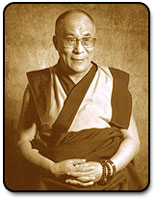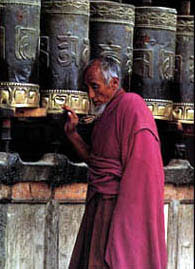|
 Tibetans
first came into contact with Buddhism when they occupied the oasis
cities of central Asia. Some time later, in the 8th century AD,
the first of many missionary monks arrived and the country's first
monastery was established in 787AD. However, despite some early
success Buddhism soon went into decline due to opposition from Bon,
the indigenous religion, and political turmoil. In the 10th century
monks from India and Tibetans going to India re-introduced the religion
together with many aspects of Indian civilisation and it soon began
to flourish. As Tantra was the main type of Buddhism in India at
the time, it was that which became established in Tibet. Tibetans
first came into contact with Buddhism when they occupied the oasis
cities of central Asia. Some time later, in the 8th century AD,
the first of many missionary monks arrived and the country's first
monastery was established in 787AD. However, despite some early
success Buddhism soon went into decline due to opposition from Bon,
the indigenous religion, and political turmoil. In the 10th century
monks from India and Tibetans going to India re-introduced the religion
together with many aspects of Indian civilisation and it soon began
to flourish. As Tantra was the main type of Buddhism in India at
the time, it was that which became established in Tibet.
A
thangka
painting of a Lama.
There
are Four Principle Schools in Tibetan Buddhism. In
the 17th century the head of the country's most powerful sect, the
Fifth Dalai Lama (1617-82), made himself king and his successors
ruled the country until 1951. Although living in a sparsely populated
and geographically isolated region, the Tibetans gradually evolved
one of the richest and most sophisticated forms of Buddhism. However,
the powerful and conservative clergy refused to allow any form of
modernisation or contact with the outside world, which made Tibet
an easy target for communist China which invaded the country in
1951. Between 1959 and 1977 almost all traces of Buddhism were destroyed
and hundreds of thousands of people were driven into exile. However,
refugee monks have been highly successful in re-establishing themselves
in India and since the 1960s have been equally successful in founding
temples and centres in the West.
 |
Tibet
i n
Exile n
Exile
The Dalai Lama and about a 100 thousand men and women went into
exile in India, in 1959. Completely destitute at the beginning of
their exile, they have succeeded in gradually rebuilding their monasteries,
preserving their culture and restructuring their society and keeping
it alive, in spite of the extremely difficult circumstances. They
have set up a government and rebuilt monasteries where masters pass
on their teachings to young monks. They built schools where they
provide a suitable education for more than 10,000 children supported
by sponsors from all over the world. These schools are rated the
best in the Himalayas. In spite of the extremely precarious circumstances
in exile, Tibetans have recreated their monastic institutions.
Tibetans
believe that the Dalai Lama is a reincarnation of Avalokiteshvara
(Ocean of Wisdom). The Potala Palace, the residence of His Holiness,
the Dalai Lama is thirteen storeys high, this vast structure on
the Red Hill, dominating the Tibetan capital, is now a museum, though
still regarded by many Tibetans as a sacred place. The present palace
was raised on the site of a much older residence in the mid-seventeen
century, in the time of the great Fifth Dalai Lama, who consolidated
the Tibetan theocracy and the dominance of the Gelugpa (Yellow Hat)
sect.
For
his part, the Dalai Lama travels around the world spreading a message
of Peace and Universal Responsibility. The Dalai Lama believes that
the common aim of all religions, an aim that everyone must try to
find, is to foster tolerance, altruism and love. According to him,
if the authentic Buddhism of Tibetan Lamas disappears from the surface
of the Earth, this loss will result in an imbalance that concerns
us all, and we must all accept responsibility for it.
OM
MANI PADME HUM
by His Holiness the Dalai Lama
It is very good to recite the mantra Om mani padme hum, but
while you are doing it, you should be thinking on its  meaning,
for the meaning of the six syllables is great and vast. The first,
Om is composed of three letters, A, U, and M. These symbolize the
practitioner's impure body, speech, and mind; they also symbolize
the pure exalted body, speech, and mind of a Buddha. meaning,
for the meaning of the six syllables is great and vast. The first,
Om is composed of three letters, A, U, and M. These symbolize the
practitioner's impure body, speech, and mind; they also symbolize
the pure exalted body, speech, and mind of a Buddha.
Can impure body,
speech, and mind be transformed into pure body, speech, and mind,
or are they entirely separate? All Buddhas are cases of beings who
were like ourselves and then in dependence on the path became enlightened;
Buddhism does not assert that there is anyone who from the beginning
is free from faults and possesses all good qualities. The development
of pure body, speech, and mind comes from gradually leaving the
impure states and their being transformed into the pure.
How is this
done? The path is indicated by the next four syllables. Mani, meaning
jewel, symbolizes the factors of method-the altruistic intention
to become enlightened, compassion, and love. Just as a jewel is
capable of removing poverty, so the altruistic mind of enlightenment
is capable of removing the poverty, or difficulties, of cyclic existence
and of solitary peace. Similarly, just as a jewel fulfills the wishes
of sentient beings, so the altruistic intention to become enlightened
fulfills the wishes of sentient beings.
The two syllables,
padme, meaning lotus, symbolize wisdom. Just as a lotus grows forth
from mud but is not sullied by the faults of mud, so wisdom is capable
of putting you in a situation of non-contradiction whereas there
would be contradiction if you did not have wisdom. There is wisdom
realizing impermanence, wisdom realizing that persons are empty,
of being self-sufficient or substantially existent, wisdom that
realizes the emptiness of duality-that is to say, of difference
of entity between subject an object-and wisdom that realizes the
emptiness of inherent existence. Though there are many different
types of wisdom, the main of all these is the wisdom realizing emptiness.
Purity must
be achieved by an indivisible unity of method and wisdom, symbolized
by the final syllable hum, which indicates indivisibility. According
to the sutra system, this indivisibility of method and wisdom refers
to wisdom affected by method and method affected by wisdom. In the
mantra, or tantric, vehicle, it refers to one consciousness in which
there is the full form of both wisdom and method as one undifferentiable
entity. In terms of the seed syllables of the five Conqueror Buddhas,
hum is the seed syllable of Akshobhya - the immovable, the unfluctuating,
that which cannot be disturbed by anything.
Thus the six
syllables, om mani padme hum, mean that in dependence on the practice
of a path which is an indivisible union of method and wisdom, you
can transform your impure body, speech, and mind into the pure exalted
body, speech, and mind of a Buddha. It is said that you should not
seek for Buddhahood outside of yourself; the substances for the
achievement of Buddhahood are within. As Maitreya says in his Sublime
Continuum of the Great Vehicle (Uttaratantra), all beings naturally
have the Buddha nature in their own continuum. We have within us
the seed of purity, the essence of a 'One Gone Thus' (Tathagatagarbha),
that is to be transformed and fully developed into Buddhahood.
Tibetan
Buddhist Links:
|
